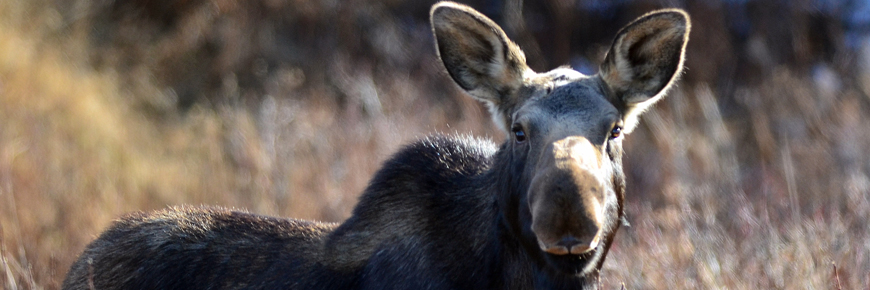
Moose
Cape Breton Highlands National Park

The moose is the largest living deer. It affects the growth of the forest in the park by selectively browsing only certain species of trees.
The moose is the world's largest living deer, standing almost two metres at the shoulder. It is characterized by its large size, long face with overhanging muzzle, dewlap or 'bell' under the throat, long legs and short tail. The moose is usually dark brown to black, with beige or gray lower legs. The moose is most active at night but can be seen any time of day. It eats non-grass herbaceous plants in the summer and the bark, twigs and buds of woody plants in the winter.
The male moose, or bull, has large, palmate antlers. They drop their antlers in the fall after the mating season, and re-grow them over three to five months in the spring and summer.
The female, or cow, moose gives birth to one or two calves in May to June. A moose can live up to 15 years in the wild.
Distribution
Moose are circumpolar, living in the boreal forests throughout the northern hemisphere. In North America, they may be found across Canada and the northern parts of the United States. Canada is home to four subspecies of moose:
- eastern moose, found from western Ontario to the Atlantic provinces
- western moose, found from British Columbia to western Ontario
- Alaska moose, found in western Yukon
- Shiras moose, found in the Rocky Mountains in southern Alberta and British Columbia
Moose population

A male moose re-growing his antlers in the spring.
Eastern moose are native to Cape Breton, but became rare by 1900 due to excessive hunting and habitat destruction, and were likely wiped out by the 1930s. Parks Canada decided to re-introduce moose to Cape Breton Highlands National Park, and 18 western moose from Elk Island National Park, Alberta, were released in Cape Breton Highlands National Park during 1947 and 1948. It is likely that all the moose in Cape Breton now are descendants of these original 18 animals. The moose found on the mainland of Nova Scotia are the eastern moose subspecies.
Wolves became extirpated from Cape Breton by the mid-1800s. Without wolves, moose have no major natural predators. Some moose are affected by a brain worm carried by white-tailed deer and some young moose may be killed by bears; however, neither of these factors is enough to control moose population.
In the 1970s, a large spruce budworm outbreak killed much of the boreal forest of Cape Breton Highlands National Park. The regeneration of balsam fir and white birch following the budworm outbreak provided large volumes of food for the moose. With an abundance of food and lack of predators, the moose population grew quickly. In 2011, it was estimated that there were two moose per square kilometer in Cape Breton Highlands National Park.
Moose are rare on mainland Nova Scotia, so why don't we move some of the Cape Breton moose to the mainland?
The moose in Cape Breton are a different subspecies of moose than those found on the mainland. Cape Breton moose are all descendants of 18 moose reintroduced from Alberta in the late 1940s, and are genetically different from the Eastern moose subspecies found on the mainland. While moving Cape Breton moose to the mainland would be one option, Provincial wildlife managers would likely prefer to reintroduce moose from New Brunswick or Quebec rather than from Cape Breton. These moose are the same subspecies and would ensure that the unique genetic make up of Nova Scotia moose would be better preserved.
Moose and forest health

A balsam fir, severely browsed by moose
The boreal forest is an important ecosystem in Cape Breton Highlands National Park. It provides habitat for the provincially-rare Canada lynx and American marten. Also, the Bicknell's thrush is a threatened species that prefers to nest in regenerating boreal forest. Unfortunately, the high numbers of moose have prevented regeneration of the boreal forest of Cape Breton Highlands National Park. In 2014 approximately 11% of the park was open grassland, in areas that were historically covered by boreal forest.
In 2007, Parks Canada constructed moose exclosures in two severely-impacted areas of Cape Breton Highlands National Park to see how vegetation recovers when it is not browsed by moose. The exclosure on North Mountain shows a remarkable increase in regeneration and tree height. A study by Saint Francis Xavier University showed that in 2012, only five years after the exclosure was built, there was seven times more biomass inside the exclosure than there was outside. This indicates that recovery is possible in some areas of Cape Breton Highlands National Park if moose numbers are reduced.
For more information on forest health and Cape Breton Highlands National Park's plans to restore the boreal forest, visit Restoring Forest Health: Grassland in the Highlands?
- Date modified :